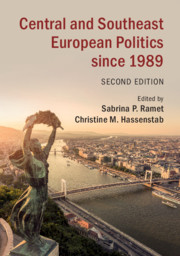Book contents
- Central and Southeast European Politics since 1989
- Central and Southeast European Politics since 1989
- Copyright page
- Dedication
- Contents
- Figures and Maps
- Tables
- Contributors
- Preface
- Glossary
- Guide to the Pronunciation of Central and Southeast European Words
- Additional material
- Part One Introduction
- Part Two Issues
- Part Three Central Europe
- Part Four Yugoslav Successor States
- 10 Slovenia since 1989
- 11 Politics in Croatia since 1990
- 12 Serbia and Montenegro since 1989
- 13 Bosnia-Herzegovina since 1991
- 14 Macedonia/North Macedonia since 1989
- 15 Kosova
- Part Five Southeastern Europe
- Part Six Present and Future Challenges
- Index
- References
11 - Politics in Croatia since 1990
from Part Four - Yugoslav Successor States
Published online by Cambridge University Press: 16 September 2019
- Central and Southeast European Politics since 1989
- Central and Southeast European Politics since 1989
- Copyright page
- Dedication
- Contents
- Figures and Maps
- Tables
- Contributors
- Preface
- Glossary
- Guide to the Pronunciation of Central and Southeast European Words
- Additional material
- Part One Introduction
- Part Two Issues
- Part Three Central Europe
- Part Four Yugoslav Successor States
- 10 Slovenia since 1989
- 11 Politics in Croatia since 1990
- 12 Serbia and Montenegro since 1989
- 13 Bosnia-Herzegovina since 1991
- 14 Macedonia/North Macedonia since 1989
- 15 Kosova
- Part Five Southeastern Europe
- Part Six Present and Future Challenges
- Index
- References
Summary
In June 1991, Croatia declared its independence from the moribund Socialist Federated Republic of Yugoslavia and immediately had to fight a defensive war against local Serb insurgents and the Yugoslav People’s Army, which enjoyed the support of Serbia throughout the four years of war. Franjo Tudjman, head of the Croatian Democratic Union (HDZ), served as president of Croatia from 1990 until his death in 1999 and dominated Croatian politics during those years. Corruption, cronyism, and nepotism were earmarks of the Tudjman era. However, after his death, there was a new start, with the erstwhile opposition party, Ivica Racan’s Social Democratic Party (SDP), winning the election of 2000. The office of prime minister was now strengthened at the expense of the presidency, thus converting the Croatian system into a typical parliamentary system. In December 2003, the HDZ returned to power, and since then the SDP and the HDZ have alternated in office. Among the challenges which Croatian governments have faced since the end of the war in 1995 have been the rebuilding of destroyed and damaged homes and infrastructure, the reintegration of those Serbs who have remained in the country, the fight against corruption, and the endeavor to join NATO and the European Union (EU). This dual endeavor was rewarded when Croatia was admitted to NATO in July 2008 and to the EU in July 2013.
- Type
- Chapter
- Information
- Central and Southeast European Politics since 1989 , pp. 273 - 308Publisher: Cambridge University PressPrint publication year: 2019

